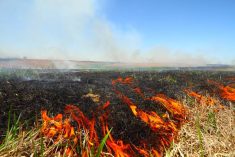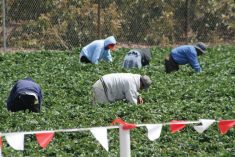Farms across Canada are becoming safer, but danger still abounds.
“We are seeing fewer entanglement injuries and fewer deaths from rollovers — that’s where the big gains are on the technology and engineering side,” said Don Voaklander, director of the University of Alberta’s Injury Prevention Centre.
“The other stuff is kind of the same. Falls and animal-related fatalities have pretty much flatlined.”
Safer equipment is a primary reason for this.
“We are getting more and more tractors with rollover protective structures and other equipment with better guarding systems that are easily taken off and replaced so they don’t get discarded and left off the moving parts,” said Voaklander. “Older machines had guards that bolted off and on, and were commonly left off after repeated need to remove.”
Read Also

Farming Smarter receives financial boost from Alberta government for potato research
Farming Smarter near Lethbridge got a boost to its research equipment, thanks to the Alberta government’s increase in funding for research associations.
As well, new Occupational Health and Safety rules (for farms with non-family employees) that came into effect in December are also pushing farms, especially large ones, to adopt practices that are the norm in other sectors.
But family members, including children, are excluded from the OHS legislation, even though family farms are the category that sees the most accident-related fatalities, said Voaklander.
“It’s an interesting conundrum because most OHS rules don’t apply if you’re a sole proprietorship — regardless if they’re a farm or not,” he said “It’s really hard to pick on family farms even though farming is very dangerous.”
But it’s not that owners of small family farms aren’t interested in making safety improvements, said Jody Wacowich, executive director of AgSafe Alberta.
Rather, there is a lot of interest from family farms on how to make their operations safer, but their owners are also frustrated because they can’t tap into existing grant programs.
“With the provincial Farm Health and Safety grant program they are disappointed that they have to have a Workers Compensation Board account to get access to that funding,” she said. “They think it should be available to them as well.”
Nevertheless, deaths from farm-related injuries have been declining. The number of fatalities fell from an average of 116 per year between 1990 and 2001 to 84 between 2003 to 2012, according to data from the Canadian Agricultural Injury Reporting program. However, Voaklander has noted that when a declining farm population (1.1 million in 1990 versus 630,000 in 2012) is factored in, the drop in farm-related deaths is a modest 1.1 per cent annually.
More recent data isn’t available, in part because the fentanyl crisis is clogging up coroners’ agendas, he said.
“We’ve been having a hard time getting access to coroners’ files because they are swamped trying to deal with the research issues around the prevention of overdoses. I just sent a nasty letter to the justice minister the other day saying that we really need to do this important evaluative work for Albertans. We will see where that goes because the bureaucrats at a certain level keep turning us away.”
New threat
And there is a new farm safety issue: Half of baby boomers are now in their senior years and many are continuing to farm.
Aside from the usual effects of age (such as diminished vision, hearing, and balance), older farmers tend to be more at risk because they are more likely to be using older equipment lacking the latest safety technology, said Voaklander, who is involved in a study following a group of Saskatchewan farmers and tracking their injury rates.
The study is finding the safest farms are the ones with access to the same kind of basic safety equipment — such as easily accessible fire extinguishers — commonly found in workplaces in other industries.
“That’s a really interesting finding because on smaller operations, shortcuts are taken that put people at risk,” he said. “But if you have the basic environment up to code and safe, it does provide a protective effect.”
The provincial government’s bill to extend OHS rules to farming sparked bitter protests in 2015 and raised the question of whether farmers are resistant to safety practices common in other industries.
Farmers want their operations to be safe but there is also another factor at play — something called “the agrarian myth,” said Voaklander.
“The idea is that farmers are a separate type of business,” he said. “When the government says it is going to bring in regulations and there might be an inspector coming to your farm, that really brings out strong feelings.”
But it’s not a view shared by the younger generation, he said.
“Some of the younger farmers taking over operations now have come back from working at Syncrude and places like that, so they’re bringing more of a safety culture back to the farm,” said Voaklander. “That will help a lot. The culture will change — it’s just that it’s a really embedded culture right now and cultural change doesn’t happen overnight.”
But agriculture isn’t like other sectors, said Wacowich.
“Certainly we are different but that’s because our homes and our workplaces are in the same place,” she said. “I think that’s why people were more upset about having this legislation come into place — the idea that you’re now putting legislation in place in my home.”
And then there’s the burden of having yet another set of regulations to deal with, she said.
“Another thing we’re finding when talking to people is we have put a lot of programs in place in agriculture,” said Wacowich. “Over the years we’ve had food safety, animal welfare, and environmental farm plan programs.
“They keep asking farmers to put these programs in place with little revenue to cover the costs.”
















